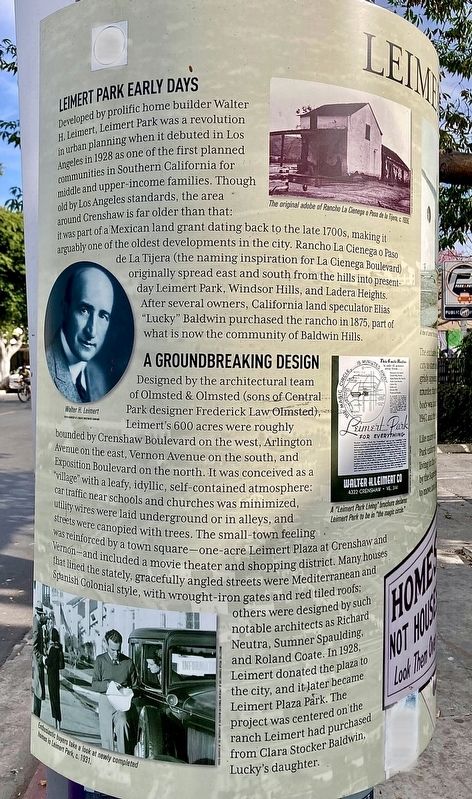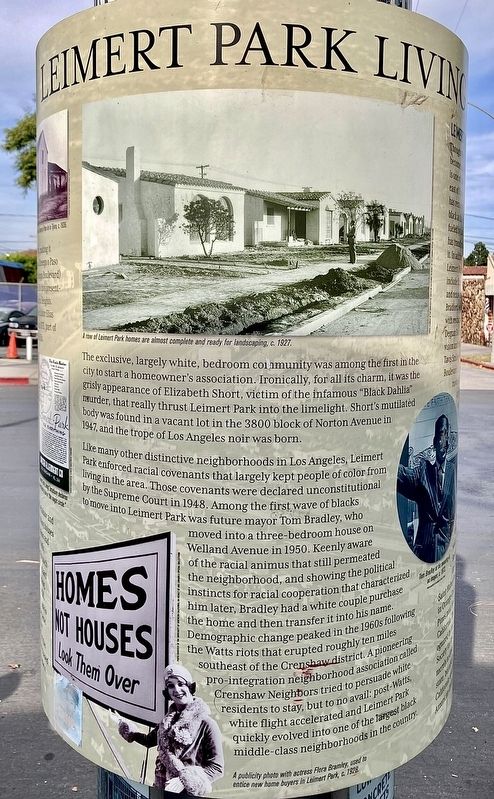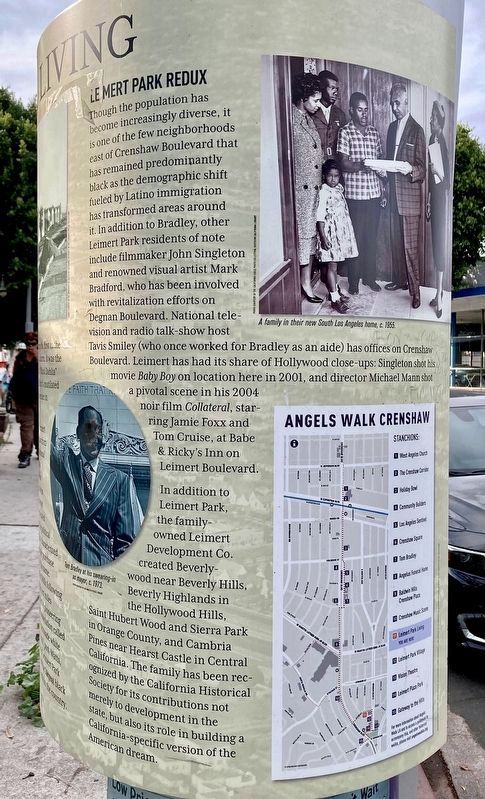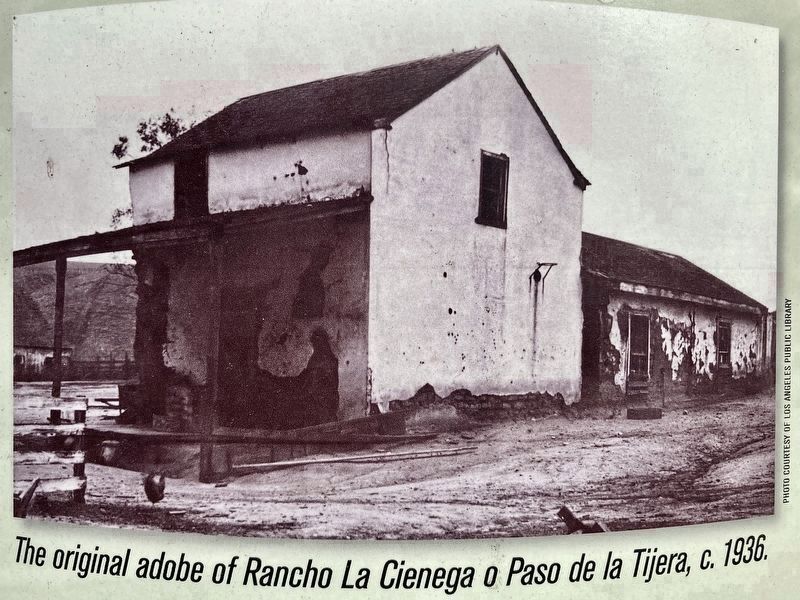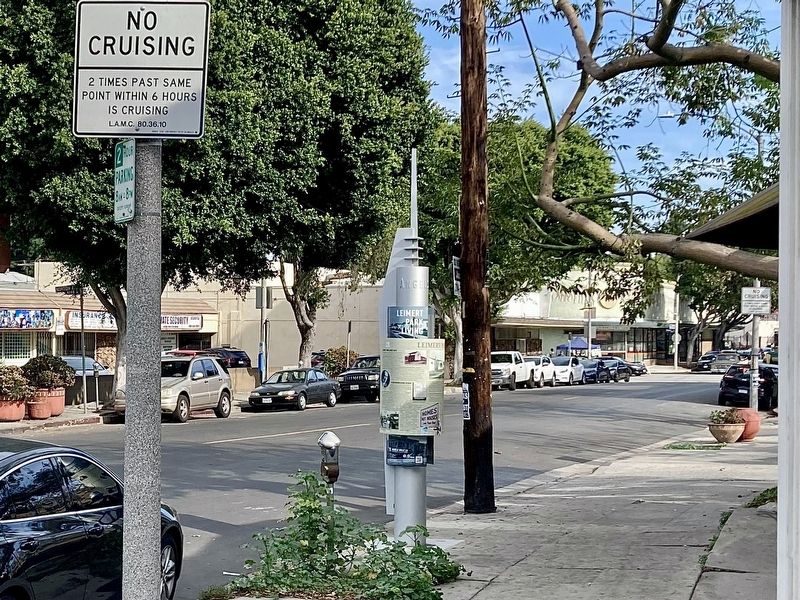Leimert Park in Los Angeles in Los Angeles County, California — The American West (Pacific Coastal)
Leimert Park Living
Leimert Park Early Days
Developed by prolific home builder Walter H. Leimert, Leimert Park was a revolution in urban planning when it debuted in Los Angeles in 1928 as one of the first planned communities in Southern California for middle and upper-income families. Though old by Los Angeles standards, the area. around Crenshaw is far older than that: it was part of a Mexican land grant dating back to the late 1700s, making it arguably one of the oldest developments in the city. Rancho La Cienega o Paso de La Tijera (the naming inspiration for La Cienega Boulevard) originally spread east and south from the hills into present-day Leimert Park, Windsor Hills, and Ladera Heights. After several owners, California land speculator Elias "Lucky" Baldwin purchased the rancho in 1875, part of what is now the community of Baldwin Hills.
A Groundbreaking Design
Designed by the architectural team of Olmsted & Olmsted (sons of Central Park designer Frederick Law Olmsted), Leimert's 600 acres were roughly bounded by Crenshaw Boulevard on the west, Arlington Avenue on the east, Vernon Avenue on the south, and Exposition Boulevard on the north. It was conceived as a "village" with a leafy, idyllic, self-contained atmosphere: car traffic near schools and churches was minimized, utility wires were laid underground or in alleys, and streets were canopied with trees. The small-town feeling was reinforced by a town square — one-acre Leimert Plaza at Crenshaw and Vernon — and included a movie theater and shopping district. Many houses that lined the stately, gracefully angled streets were Mediterranean and Spanish Colonial style, with wrought-iron gates and red tiled roofs: others were designed by such notable architects as Richard Neutra, Sumner Spaulding, and Roland Coate. In 1928, Leimert donated the plaza to the city, and it later became Leimert Plaza Park. The project was centered on the ranch Leimert had purchased from Clara Stocker Baldwin, Lucky's daughter.
The exclusive, largely white, bedroom community was among the first in the city to start a homeowner's association. Ironically, for all its charm, it was the grisly appearance of Elizabeth Short, victim of the infamous "Black Dahlia" murder, that really thrust Leimert Park into the limelight. Short's mutilated body was found in a vacant lot in the 3800 block of Norton Avenue in 1947, and the trope of Los Angeles noir was born.
Like many other distinctive neighborhoods in Los Angeles, Leimert Park enforced racial covenants that largely kept people of color from living in the area. Those covenants were declared unconstitutional by the Supreme Court in 1948. Among the first wave of blacks to move into Leimert Park was future mayor Tom Bradley, who moved into a three-bedroom house on Welland Avenue in 1950. Keenly aware of the racial animus that still permeated the neighborhood, and showing the political instincts for racial cooperation that characterized him later, Bradley had a white couple purchase the home and then transfer it into his name. Demographic change peaked in the 1960s following the Watts riots that erupted roughly ten miles southeast of the Crenshaw district. A pioneering pro-integration neighborhood association called Crenshaw Neighbors tried to persuade white residents to stay, but to no avail: post-Watts white flight accelerated and Leimert Park quickly evolved into one of the largest black middle-class neighborhoods in the country.
Leimert Park Redux
Though the population has become increasingly diverse, it is one of the few neighborhoods east of Crenshaw Boulevard that has remained predominantly black as the demographic shift fueled by Latino immigration has transformed areas around it. In addition to Bradley, other Leimert Park residents of note include filmmaker John Singleton and renowned visual artist Mark Bradford, who has been involved with revitalization efforts on Degnan Boulevard. National television and radio talk-show host Tavis Smiley (who once worked for Bradley as an aide) has offices on Crenshaw Boulevard. Leimert has had its share of Hollywood close-ups: Singleton shot his movie Baby Boy on location here in 2001, and director Michael Mann shot a pivotal scene in his 2004 noir film Collateral, starring Jamie Foxx and Tom Cruise, at Babe & Ricky's Inn on Leimert Boulevard.
In addition to Leimert Park, the family-owned Leimert Development Co. created Beverlywood near Beverly Hills, Beverly Highlands in the Hollywood Hills, Saint Hubert Wood and Sierra Park in Orange County, and Cambria Pines near Hearst Castle in Central California. The family has been recognized by the California Historical Society for its contributions not merely to development in the state, but also its role in building a California-specific version of the American dream.
Erected 2018 by City of Los Angeles.
Topics. This historical marker is listed in these topic lists: African Americans • Settlements & Settlers. A significant historical year for this entry is 1928.
Location. 34° 0.356′ N, 118° 19.952′ W. Marker is in Los Angeles, California, in Los Angeles County. It is in Leimert Park. Marker is at the intersection of 43rd Street and Norton Avenue, on the right when traveling east on 43rd Street. Touch for map
. Marker is at or near this postal address: 3428 W 43rd St, Los Angeles CA 90008, United States of America. Touch for directions.
Other nearby markers. At least 8 other markers are within walking distance of this marker. Leimert Park Village (about 300 feet away, measured in a direct line); Leimert Plaza Park (about 600 feet away); Leimert Plaza (approx. 0.2 miles away); Gateway to the Hills (approx. 0.2 miles away); Crenshaw Music Scene (approx. 0.2 miles away); Crenshaw Plaza (approx. 0.4 miles away); Doumakes House (approx. 0.6 miles away); Tom Bradley (approx. 0.6 miles away). Touch for a list and map of all markers in Los Angeles.
Also see . . . Angels Walk L.A. Self-guided walking tours of historic neighborhoods in Los Angeles. The Leimert Park Living marker is part of the Crenshaw walk. (Submitted on December 11, 2023.)
Credits. This page was last revised on December 11, 2023. It was originally submitted on December 10, 2023, by Craig Baker of Sylmar, California. This page has been viewed 149 times since then and 110 times this year. Photos: 1, 2, 3, 4, 5. submitted on December 10, 2023, by Craig Baker of Sylmar, California.
